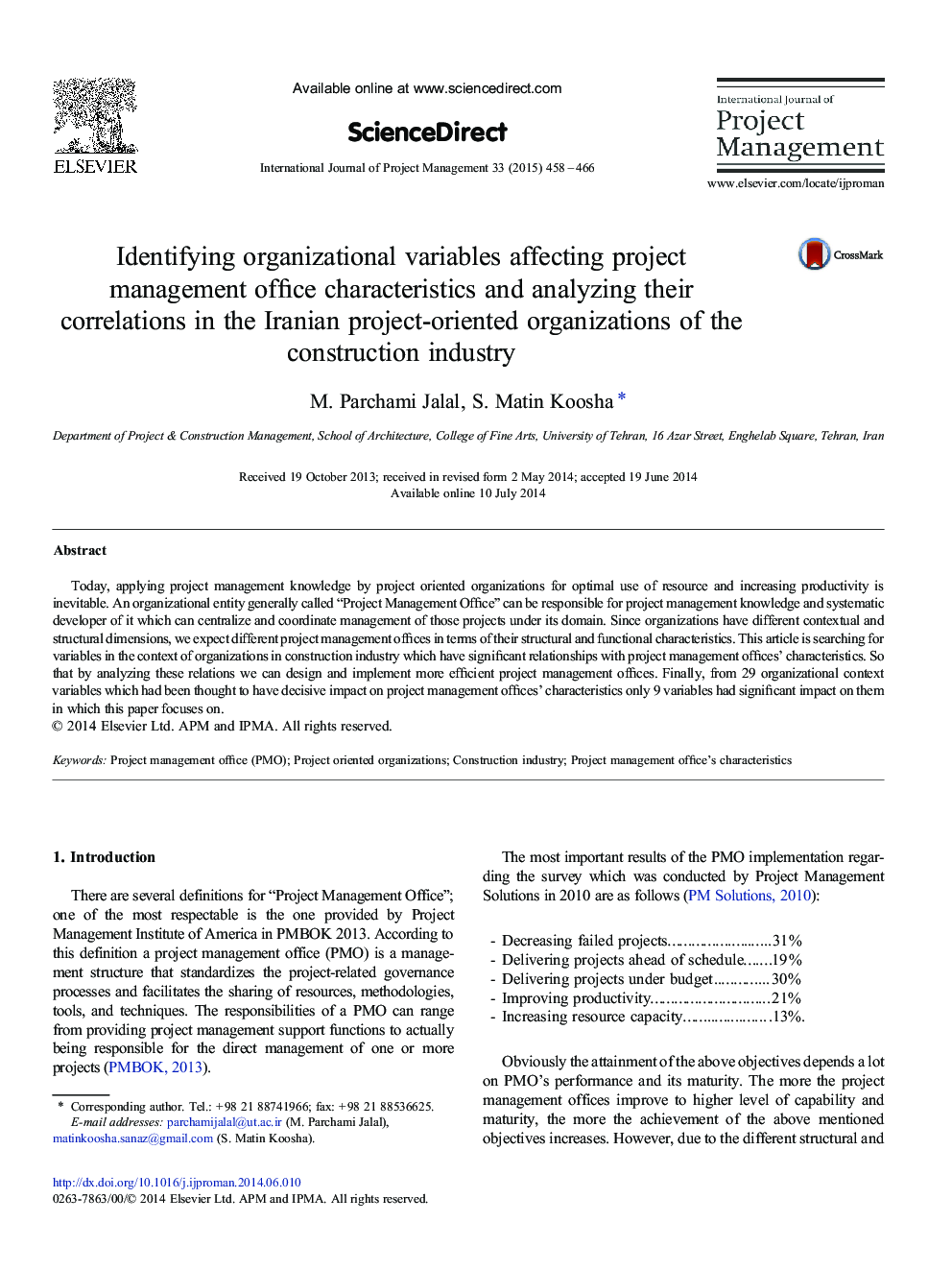| کد مقاله | کد نشریه | سال انتشار | مقاله انگلیسی | نسخه تمام متن |
|---|---|---|---|---|
| 275750 | 1429674 | 2015 | 9 صفحه PDF | دانلود رایگان |
کلمات کلیدی
1- مقدمه
1-1- ویژگیهای دفاتر مدیریت پروژه
1-2- متغیرهای زمینه سازمانی
جدول 1- طبقهبندی توابع PMOها از دیدگاه این مطالعه.
جدول 2- ویژگیهای ساختاری PMOها از دیدگاه این مطالعه.
2- روش تحقیق
2-1- مرحله اولویتبندی متغیرهای زمینه سازمانی از دیدگاه کارشناسان
2-1-1- ابزار گردآوری دادهها و جمعیت آماری
2-1-2- روش تجزیه و تحلیل در این مرحله
2-2- مرحله ارزیابی همبستگی بین متغیرهای زمینه سازمانی و خصوصیات دفاتر مدیریت پروژه
2-2-1- روش جمعآوری دادهها و نمونه پژوهش در این مرحله
شکل 1- متغیرهای زمینه سازمانی.
جدول 3- متغیرهای زمینه سازمانی تأثیرگذار بر ویژگیهای دفتر مدیریت پروژه در صنعت ساخت و ساز ایران.
2-2-2- تکنیک و نتیجه ارزیابی همبستگی بین متغیرهای پژوهش
شکل 2- مشخصات پاسخدهندگان در مرحله 1.
3- نتایج و بحث
3-1- حمایت مدیران ارشد سازمانی
3-2- ساختار مدیریت پروژه در سازمان
جدول 5- ضرایب همبستگی و اندازهگیری نرخ خطای آنها. 3-3- حضور متخصصان مدیریت پروژه در سازمان
شکل 3- راهنمای جدول 5.
3-4- میزان فرآیندهای مدیریت پروژه مورد نیاز توسط سازمان
شکل 4- همبستگی معناداری بین متغیرهای زمینه سازمانی و ویژگیهای اداره یا دفتر مدیریت پروژه یافت شد.
3-5- رابطه بین استراتژیهای سازمان با توسعه مدیریت پروژه
3-6- اندازه پروژه سازمان بر حسب مدت زمان
3-7- اندازه پروژه سازمان بر حسب تعداد کارکنان
3-8- تعداد پروژههای همزمان در سازمان
3-9- توزیع جغرافیایی پروژههای سازمان
4- نتیجه گیری
• Classifying Project Management Offices’ Characteristics.
• Compiling important Organizational Variables affecting PMOs’ Characteristics.
• Analyzing correlations between Organizational Variables and PMOs’ Characteristics.
• Founding the most important Organizational variable for PMO.
Today, applying project management knowledge by project oriented organizations for optimal use of resource and increasing productivity is inevitable. An organizational entity generally called “Project Management Office” can be responsible for project management knowledge and systematic developer of it which can centralize and coordinate management of those projects under its domain. Since organizations have different contextual and structural dimensions, we expect different project management offices in terms of their structural and functional characteristics. This article is searching for variables in the context of organizations in construction industry which have significant relationships with project management offices' characteristics. So that by analyzing these relations we can design and implement more efficient project management offices. Finally, from 29 organizational context variables which had been thought to have decisive impact on project management offices' characteristics only 9 variables had significant impact on them in which this paper focuses on.
Figure optionsDownload as PowerPoint slide
Journal: International Journal of Project Management - Volume 33, Issue 2, February 2015, Pages 458–466
